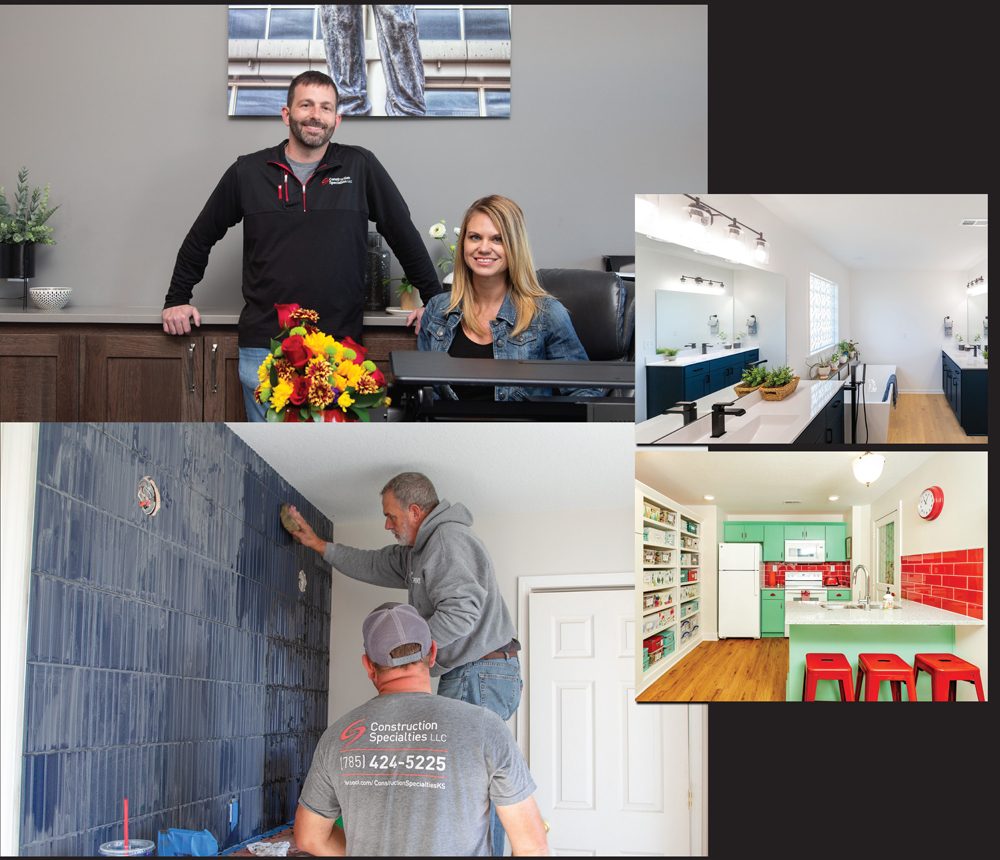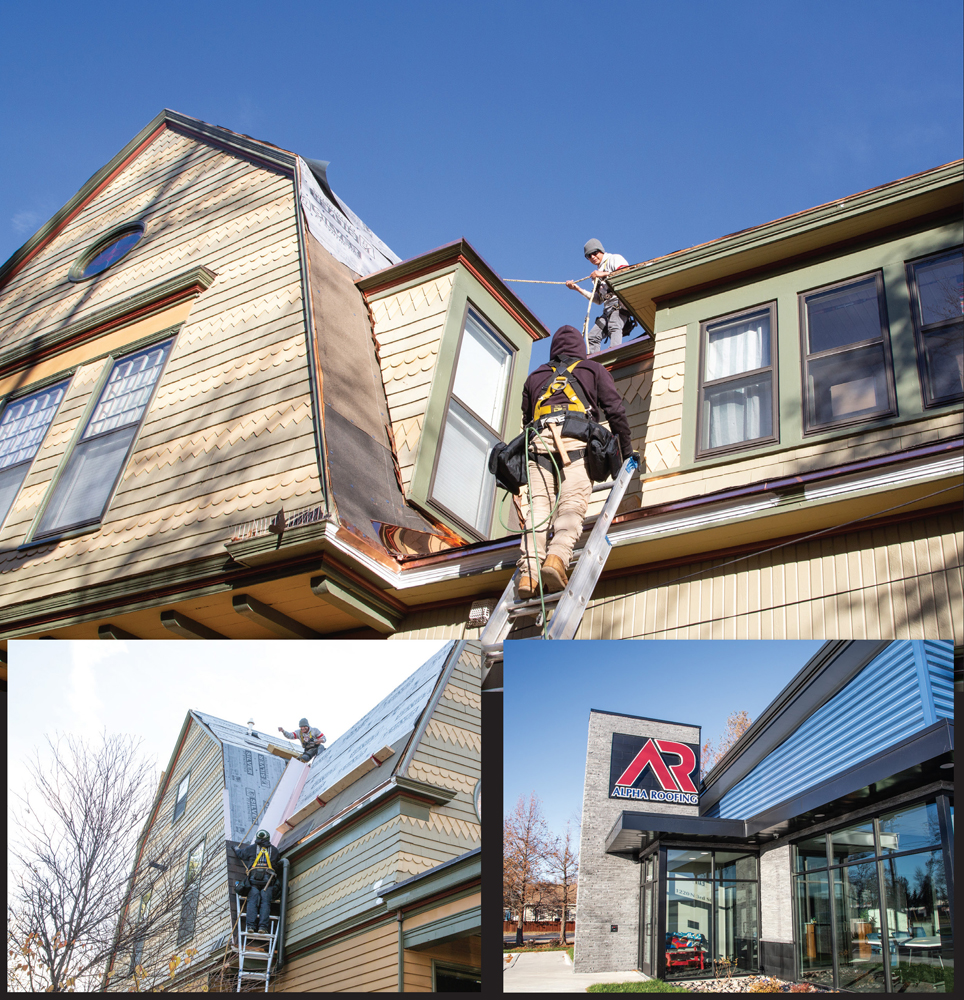| story by | |
| photos by | Steven Hertzog |
| OPEN A PDF OF THE ARTICLE |
A combination of innovation, design and mathematics is the perfect cocktail these businesses use to create top-notch products and to satisfy their clients.

Renderings for the new KU football stadium designed by Multistudio, an architectural firm in downtown Lawrence
From the time we get up in the morning until the time we go to bed, mathematics is an integral part of our daily functions. Managing our time, using a budget, driving, cooking, paying the tab at restaurants, exercising, working. There’s very little in our daily lives in which we don’t use math.
According to Cuemath, a leading online math education platform started in 2013, math helps make life orderly and less chaotic, nurturing the powers of reasoning, creativity, abstract or spatial thinking, critical thinking, problem-solving and effective communication skills. Cuemath’s mission is to transform the way children learn math, and the company is backed by investors like Google, Bloomberg and Forbes. It has locations in all 50 states and can be found in more than 80 countries.
“Math is a tool in our hands to make our life smoother. The more mathematical we are in our approach, the more rational would be our thoughts,” the site continues. “Math is a medium that should be embraced by everyone in all our walks of life.”
Cuemath explains that mathematics creates better problem-solving skills and increased analytical thinking and reasoning abilities in individuals, skills essential in thinking logically about situations and helping people solve problems and look for solutions.
So what impact does math have on the business world? What types of professions use math and for what purposes?

Renderings for the new KU football stadium designed by Multistudio, an architectural firm in downtown Lawrence
From the Ground Up
At Multistudio, a Downtown Lawrence architecture firm that has been in operation here for more than 50 years (originally Gould Evans), the aim is to work on projects that can make the most impact in the community and provide an opportunity for its employees to bring value to whatever problem a client is trying to solve, says CJ Armstrong, vice president and architect at Multistudio. The firm, which employs about 150 people in different bases across the country, focuses mainly on commercial work, but each office across the country has a distinct specialty, including house branding, landscape architecture, urban planning, interior design and architecture, to name a few.
“We pull on all of those talents, depending on whatever project is working,” he explains. It’s not uncommon for someone from San Francisco or Phoenix or New Orleans to help the Lawrence office on a project or vice versa. “We try to stay pretty flexible and nimble.”
Armstrong says math is elemental to architectural design. “Regardless of what you draw, someone must build it, and they cannot do that unless you provide the geometric information to assemble the pieces.”
He explains that math has traditionally been the foundational component of architecture, allowing a project to go from 2D-drafted designs to built structures. “We are using more than just geometry but complex mathematical algorithms to develop generative designs. We are able to process massive pools of data to inform our projects at a level unheard of a decade ago.”
The majority of Multistudio’s daily design work is geometry and algebra, Armstrong says. Other areas of math used at the firm include logic, statistics and computational (computer-assisted) math, depending on a project’s specific needs. Architects must geometrically tell a contractor how to build what they’ve drawn, make sure dimensions add up, understand tolerances (how close things can fit together without causing interference) and be able to understand the relationships of different sized objects to one another. “And a big portion of what we do is helping clients understand budgets and construction costs. So there’s an algebra component to that.”
Multistudio architects also use generative design, tasking the computer with doing data set analysis. “There’s a software platform we use that effectively creates genomes of your design, so you can test thousands of iterations of your design based off of constraints that you give it, and it tries to find the best fit,” he continues. “So it’s going through and following the algorithms and calculations that you set up to come up with a best fit solution.”
LOCAL MATTERS
Our Local Advertisers – Making a Positive Impact
The software provides a visual representation of what the code the architect is linking together is doing. These links feed data and information and data sets from one node to another. The architect can build out complex geometry and scripting processes without actually having to do the math. “Being able to automate that is huge,” Armstrong explains. “With the advent of AI (artificial intelligence), that’s getting exponential. Now we are literally trying to understand what data we currently have and how to mine that data, how to extract pertinent information out of it.”
Multistudio is currently working on transforming the David Booth Kansas Memorial Stadium into the University of Kansas Gateway District. It will include a reimagined stadium, a new conference center, multiuse facilities that can be used year-round, new retail, dining and other amenities. A project this large is multidimensional and complex.

Construction Specialties CEO Mike Warner and Interior Designer Sarah Kellogg, in their showroom in Lawrence, Ks. The bathroom was a complete remodel. They replaced the cheap box store shower with a custom Onyx shower that will make it easy to clean and wont leak. They took out the large clunky whirlpool tub and put in a freestanding tub. The bathroom is now modern, bright and functional.
Their client’s vision for her kitchen was based on a Betty Crocker’s advertisement which pictured a red and green kitchen.
The client wanted a retro feel that went with her nick nak’s. It turned out picture perfect!
A Community Project
Early planning on the Gateway project took about a year. That included talking through the project with all parties involved, putting together sketches, idea generation, discussing seat counts, capacity and budgets. Next, discussion turned toward creating the design and the process. “Once we get a sense of the general direction (of a project), then we start actually putting pen to paper,” Armstrong explains. “What’s this actually going to look like? How do we take this very complex 3D structure and make a set of 2D drawings that somebody has to build off of?”
Today, the stadium design is largely locked in in terms of the design of the bowl, the lighting and seat counts. “Now we’re into what we call a construction document phase, where we’re largely going through the mathematical process of making sure we’re meeting all of the code requirements. Do we have the correct number of toilets? Do we have the correct clearances to make sure that somebody in a wheelchair can get in?”
The International Code Council requires use of a code book that “addresses design and installation of innovative materials that meet or exceed public health and safety goals.” Its aim is to preserve public health and safety, and provide safeguards from hazards associated with the built environment. “It’s several thousands of pages of all the standards we must abide by. They’re basically very complicated word problems,” Armstrong explains. “If you have this situation, you must comply with this. They are standards that we all have to meet in order for a building to be compliant and fit the needs of the community.”
And many different entities get involved in the process. The City of Lawrence and the State of Kansas will review all the documents on the Gateway project and make sure local, state and national regulations are met. The State Fire Marshall has a set of codes that must be followed. Lawrence-Douglas County Fire and Medical has its own codes. Each group does a review to make sure the project is in compliance with its specific codes. “Lots of people are looking in because it’s a huge project, and we want to make sure people are safe,” Armstrong continues. And those codes extend not just to architecture, but they have a separate set of codes for structure, mechanical, electrical and plumbing, and fireproofing. Every component of the building has some set of regulations that dictate how it has to go together.
“KU has been a great partner, not just in this but in a lot of the other projects we’ve done on campus. And Lawrence, as a whole, has a lot of voices and opinions, which is actually a great thing. It’s been a good home for us,” he adds.
Creating Beauty Through Math
Construction Specialties, local construction and remodeling professionals, specializes in remodeling kitchens and bathrooms, as well as construction additions and some exterior work, says Mike Warner, CEO and partner. “We offer guidance that makes our customers’ tastes pop and help guide them through the decision-making process in a straightforward and logical format. A lot of what we do is coordination of ideas between vendors and other contractors to produce the desired results.”
He explains that residential remodeling is much different than commercial, because their customers live in the environment they are working on and are invested personally and financially in the project. “The process is intimate,” he says. “When you input customers with varying degrees of experience and ability to visualize the results, sometimes you can have a challenging environment. But this is what we love to do, and our results speak for themselves.”
Warner says math is the most important part of what he does all day every day. “On my computer right now, if you look, you see nothing but math. This is a software program that works with sizes and shapes.” The software he uses daily creates 3D layouts—he draws out the space, and the computer does a lot of the math, including estimating remodeling projects, figuring out quantities, detecting risk factors and trying to figure out tolerances for risk to make sure the numbers are keeping track of how things might vary.
“But I still am doing tons of math. There’s a lot of algebra,” he explains. “Pythagorean theorem, A squared plus B squared, we use a lot of that. In construction, the 3:4:5 method of squaring things up (a three-foot length on your straight line, a four-foot length on your perpendicular line and a five-foot length across makes a perfectly square corner).”
Warner says he spends about 20% of his time with financial numbers of one sort or another, whether it’s budgeting for the company or talking about budgeting on jobs. He creates closing reports for jobs and sits down and goes through margins, among other things, with employees to make sure the company is profitable.
Other ways Construction Specialties uses math: to figure out square footage of siding, how many linear feet on products such as trim as well as ratios. “You can imagine that if you’re trying to figure out the linear footage of a whole house, it’s kind of difficult unless you literally spend the time to go measure every single piece of trim,” Warner continues. “You have to understand a lot of things about math to be able to put all those parts together.”
Sarah Kellogg, interior designer with the company, agrees. “I do a lot of budgeting, space planning, dimensioning and figuring costs and amounts of materials. Algebra and geometry are used on a daily basis. Figuring areas, square footage and percentages are examples of the math I do.”
In a typical kitchen remodel, Warner creates an estimate, which includes budgets for materials and labor. Kellogg is in charge of the budgets and monitors Excel spreadsheets for each client, which helps her track costs of their selections. She conducts measurements in clients’ homes, including square footages for flooring, backsplash, countertops, etc., to determine how much material is needed. This number determines the square footage price range to stay in for the sake of each client’s budget.
She then takes those details to create a floor plan with kitchen and bath design software. “Math is critical here when space-planning cabinetry. If measurements are off or miscalculated, the layout may be problematic or wrong at the time of installation, which can be costly,” Kellogg explains. She also submits everything to suppliers for bids and ensures clients stay on budget.
Kellogg is part of the management team working directly with clients, but she also does behind-the-scenes work such as social media, applying for permits, creating job books and ordering materials for most jobs. She also works with the media and production team, website designers and photographers to ensure company projects are well represented and shine online and in publications.
“First and foremost, function is so important in the spaces we live and work in,” Kellogg explains. “Designers have the ability and duty to ensure the spaces we design are curated specifically for the people who are going to use that space, all while making it aesthetically pleasing.”
The Client is Key
Warner says one of the things he thinks some people in business may not understand is the difference between markup and margin, and the importance of both. “You definitely need to understand that they’re not the same word. And they definitely mean different things. The markup is how much you increase the price of something, and the margin is basically what you end up with at the end.”
And keeping track of time is also key. “Everybody wants to know when their project is going to start and how long it’s going to take. In our world, every single project that we do is something that’s never been done before, completely custom—a different shape, a different size, a different age of house. There’re 101 different aspects that all play into that.” He says being able to look at all of that and create statistics—how long it’s going to take to get something done, the risk factors, how much you figure in, how you combat risk, do you just put a bunch of markup on top of it, do you solve the problem with historical data and math?
“Mistakes happen all the time. It’s not a question of whether there’s going to be mistakes, it’s just how you deal with them,” Warner believes. “A lot of being successful, in my opinion, is … knowing what you need to figure out. I’ve spent a lot of time over the last nine years learning. And a lot of my learning has come through making mistakes.”
He says in this business, what’s important is the client. “We’re working directly for somebody who is using it, people who are there, living in this space that we’re working on. It’s not a business, it’s their own money. We really like residential construction … because we like to develop those relationships with the customers and get to know them, and come back and do their next job.”

Alpha Roofing replacing a roof and using copper siding at this old beautiful home in west Lawrence; Outside of the new Alpha Roofing headquarters in North Lawrence
A Consistent Outcome
Since 2004, Alpha Roofing has provided residential and commercial reroof, new construction and repair services to its clients. There is not typically a design component to residential work, as the existing roof system dictates what is installed, and new construction is dictated by the architect or builder. However, “Commercial roofing allows us to flex our design muscle more due to the ever-changing and updating of roof requirements of the flat-roof systems,” says Yvonne Ruder, COO. “Our estimators often lead the roof-design conversation, as we share the manufacture requirements for installation of Tier 1 products with architects and builders.”
For roof systems, design is important, as the certified roofers include many factors to create a barrier to moisture intrusion, insulation and ventilation requirements. “An imbalanced system will leave you with many problems down the road,” Ruder continues.
With 15 employees and three outside salespersons, Alpha’s process is consistent. A residential roof takes one to two days to complete even though every house and location is different, Ruder explains. They consider logistics, safety and quality of installation on every project. “In our commercial division, extensive strategy takes place. There are many factors that have to be considered. such as weather, product availability and timing, dictated by customers’ needs.
“Math is a major and primary component of our estimation,” she continues. “From the size of the roof to the amount of ventilation and insulation required for a balanced roof system to the actual numbers that go into each component ordered and calculated for labor, math is the single most important component.” For example, a roof is measured using geometry and simple math, which includes the imperfect shapes and waste factors.
Ruder’s job focuses on process and cost management. “From the team that we have assembled to the way we manage our products and customers, fleet management, invoicing, collection and company budgeting, math is a part of every step I complete in a day,” she adds.
Ruder says being aware of the budget is vitally important. Project costs coming in as expected on a current job is key initially but equally important to each job down the road. “We evaluate each job at completion to find out if any lessons are to be learned,” she explains.
“Our math is easy, but it is rarely simple,” Ruder says. “Calculating the cost of a happy customer, knowing when it is better to do the right thing regardless of the cost is always a calculation. Our customers are educated and want a good-quality product installed by a civic-minded business.”
The Right Ingredients
Lawrence’s thriving entrepreneurial spirit creates a business environment that is active and cares about growth. Each of these businesses strives to provide the utmost in client satisfaction and uses its resources to the fullest to create the best product possible—with a little bit of math mixed in. “You know, cooking is a word problem, and it gets you to this perfect loaf of bread. Architecture, same deal,” Armstrong explains. “You’re still doing word problems, just on a different scale. You’re following a different recipe.”




